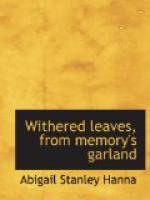How proper it seems that a navigator should stand at the entrance to pilot the way, and we can but think Spurzheim is taking his scientific observations, as his bust stands as though looking upon the passers by as they pursue their way to the city of the dead.
We passed on our way through the winding avenues, presenting their striking and varied emblems, speaking so forcibly to the mind. The white dove with open beak and half spread wing; the harp with the broken string, and the broken column, are all beautiful and significant representations, preaching loudly for the silent dust that slumbers beneath them.
As we ascended to the tower, we passed the yard enclosed with the beautiful bronze fence. Looking from the tower you witnessed life with its struggles, its comforts and luxuries; but the graves beneath us say, “we must leave all, and come and make our beds with them.”
How striking is the anxious expression of the faithful dog, keeping patient watch over the grave of his young master, through summer’s sultry heat, and winter’s pinching cold, never betraying his trust. How beautiful, and yet how simple is the touching inscriptions, “My Father,” “My Mother.” Neither name or age are mentioned to the stranger, yet what a volume is spoken directly to the heart. The white lambs reposing upon the grassy mounds represent the innocence that slumbers beneath.
Many little tokens are scattered round here and there, as mementoes of fond affection. As we gazed upon the fresh boquets, wet with the dew of night, we felt that love lingered around those places, and the tears of affection often fell there.
The flowers, beautiful though they are, either at the tomb or the bridal, give us no name or trace of former days, but lay scattered round in rich profusion, telling us of love and affection that cannot perish, because they are amaranthine flowers that have their root in the mind, and bear the impress of immortality; and as we gaze upon the beautiful, either in nature or art, it becomes daguerreotyped upon the soul, and thus lives forever, coming up at the touch of memory’s wand, with all the vividness of a first impression.
The forest trees standing in solemn grandeur, the winding avenues, the sloping hills, the deep dells, with the placid waters sleeping in their bosoms, with the bright red flowers contrasting with the white polished marble monuments, all conspire to render the place one of extreme beauty and interest. But when we compare this with the descriptions we have read of Westminster Abbey, covered with the mouldering dust of ages, as generation after generation has been added to it, we can picture to the imagination the change passing years will make here. The silent hand of time will steal by degrees, the freshness and beauty from the polished marble, effacing their beauties, one by one, ’till all are obliterated, and green mould and moss occupy their places, and the monument shall cease to be a memorial.




